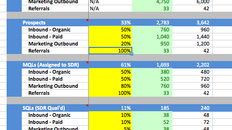
Why is this bad?
- No common definition of marketing success - if revenue goals aren’t set for marketing and a model doesn’t exist, how does the marketer, or the company, know what marketing success looks like?
- Creates climate of small thinking - the most effective management strategies are those that empower teams to take ownership and to act strategically. A marketing team that has clear goals and has access to resources to reach those goals, will always outperform micro managed teams who are reduced to measuring success by asking “Did I complete the work I was told to do?”
- It makes forecasting difficult - my former boss, Jon Miller, co-founder and VP of Marketing at Marketo, says companies should go to their VP of sales to learn how they will do this quarter, but they should go to their VP of marketing to learn how they will do next quarter. (I am definitely misquoting him here). The idea being that if your company has a 3 month sales cycle, at the start of Q1 the majority of the deals that will close in Q2 aren’t in the sales pipeline yet. But they are in the marketing pipeline as names and MQL’s. Marketing pipeline stages are leading indicators that can forecast future sales performance AND they do it far enough in advance that corrective action can be taken if needed.
- Makes it more challenging to determine future marketing budgets - if there is no straight line between marketing generated $ and marketing spend, it can lead to the perception that marketing investment is a checkbox, not a lever the company has to drive revenue growth. A model will help marketers first prove their impact on company revenue goals, then make a case for appropriate levels of investment in future periods.
- It harms marketing and sales alignment - If your SVP of sales’ strategy or the salesforce’s tactics are out of line with marketing focus and spending, that is a recipe for internal dysfunction and skinny sales commission checks.
- It makes it difficult to triage pipeline issues - all marketing starts with time and money, and hopefully ends with new customers, however there are many, many pipeline stages in between. If your company is experiencing pipeline weakness, is it a sales execution issue, a lead qualification issue, or a lead generation issue? The definition, measurement, consideration, and optimization of all pipeline stages (Names, prospects, MQL’s, etc…) will make it easy to trace pipeline problems back to the true cause.
Convinced? If so, stay tuned for a post tomorrow on modeling best practices and the release of a free modeling template that will allow you to plug in your goals and automatically see month by month targets across all pipeline stages.
Thanks for your interest!
-Chris
by Chris Russell


 RSS Feed
RSS Feed